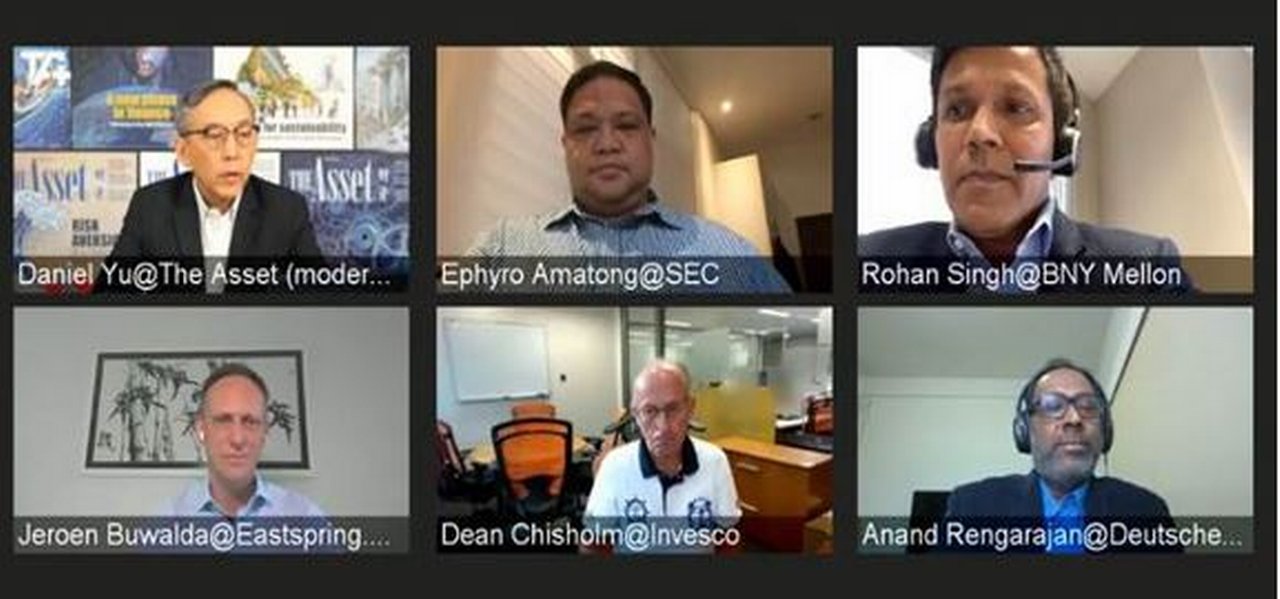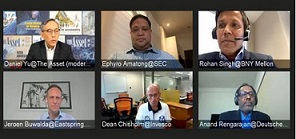July 2020
The first event of “The future of Asset Servicing Leadership Series”, organised by The Asset magazine in collaboration with Deutsche Bank, looked at how Covid-19 is accelerating digital transformation of the securities services industry in Asia
While the securities services industry can consider that it has had a “good crisis”, with market infrastructures proving resilient and asset managers and custodians largely able to operate from home as normal, Covid-19 has nonetheless made the need for further digitalisation even more apparent.
Kicking off the “The future of Asset Servicing Leadership Series” on 24 June, Commissioner Ephyro Amatong from the Securities and Exchange Commission (SEC) Philippines shared an anecdote from a webinar he had recently attended. The CFO of one of the Philippines’ largest property developers was asked was the biggest driver of digital transformation within his organisation the CEO, the CFO, or the CTO? None of them, he replied; rather, it was Covid-19.
It is the same for securities post-trade, although digital transformation is nothing new to the industry. Eastspring Investments embarked on a major digital upgrade in the years before the onset of Covid-19 – something Jeroen Buwalda, the asset manager’s COO, credits for their seamless transition to working from home. Similarly, technological improvements at Invesco have bolstered their response to the crisis, said its Regional Head of Operations, Dean Chisholm.
“Two years ago, I said that we were at the cusp of a paradigm shift,” said Anand Rengarajan Head of Securities Services, Asia Pacific, Deutsche Bank. “As an industry, we have all worked on various digital initiatives that have been necessary from an efficiency and regulatory perspective – and that journey has helped us overcome the current situation successfully. But we are not at the end of this paradigm shift, and some aspects of the industry’s digital transformation still need to be accelerated.”
Rengarajan added that, while the bank had a clear Business Continuity Plan (BCP), a global pandemic was outside the realms of what they – and others – had considered a worst-case scenario. Yet the success of the response and the move to home-working has led many to consider whether their BCP back-up sites are actually needed, he said.
Rohan Singh, Managing Director, Head of Asset Servicing, Asia Pacific, BNY Mellon, commented that homeworking was made more challenging by the fact that it coincided with “an avalanche of volumes”. “We had more than US$3trn in payments in the last two weeks of March, market volatility spikes were hitting 1.3-1.4 standard deviations and FX trade volumes were 50,000 a day, more than double the 2019 average,” he said.

What’s driving the digitalisation agenda?
Covid-19 has therefore accelerated the need for digitalisation – with the move from wet signatures to digital ones a necessary, and immediate, response to the crisis. “We’ve managed to very quickly implement a system to be able to sign off on documents digitally rather than physically and we’ve seen great collaboration across the industry with banks such as Deutsche Bank and BNY Mellon,” said Buwalda.
More broadly, Buwalda explained that Eastspring has managed to automate or outsource over 80% of its processes across the front, middle and back office: “This leaves me with around 3,000 manual tasks,” he said. “Using RPA [Robotic Process Automation] I can remove another 1,000 of those. But the final 2,000 are the hardest ones to automate and we may never be able to do this – areas such as exceptions management, governance, oversight and issue management may always need human involvement.”
Invesco’s Chisholm added that asset managers are increasingly focusing on oversight of the risks associated with RPA – something that is also high on the agenda for the International Organization of Securities Commissions (IOSCO)1. Such oversight can be labour-intensive, he said, and collaboration tools used in conjunction with service providers and other counterparties are a strong way of facilitating this in a more efficient manner.
In a poll of 315 audience members 42% identified increased efficiency as the key driver of technology adoption, followed by enhancing client experience (23% of votes).
No one size fits all
Efficiency is important, agreed Buwalda, but there are many other use cases that don’t fall in this bucket. “Often we use bots for complex processes that need to be done infrequently,” he said. “It’s not a huge saving, but because of the infrequency and complexity, there’s a high chance that a human doing the job may make a mistake. When using a bot, with all the permutations programmed, you have a higher level of confidence that it will follow the process as intended.”
Buwalda also pointed to trigger events in other time zones – while his team could stay up through the night in case an issue occurs, it makes more sense to automate the task this, allowing his staff to rather focus on oversight, design and dealing with vendors and service providers.
“Making our clients more efficient is critical to our success,” said Singh. He explained that even pre-Covid his bank was heavily focused on connecting systems and facilitating open ecosystems. “Our clients will use multiple vendors and multiple applications – if we can better connect these with our own systems then we can remove some of the latency of the process and allow portfolio managers to execute decisions more quickly.”
"There is no one size fits all answer for all the different markets in Asia”
Of course, each client will be at different stages of their transformation journey and “there is no one size fits all answer for all the different markets in Asia”, commented Rengarajan. He added, “some clients are way ahead and some are slightly earlier in their digital transformation journeys. Bringing all of them together to run at the same pace as we all want the industry to run is a challenge.” Rengarajan said that, for this reason, Deutsche Bank aims to find solutions that can be deployed across its full suite of client types and irrelevant of the size or sophistication of the asset manager.
In Asia, financial inclusion is also a key driver of digitalisation. Commissioner Amatong explained that the SEC is driven by trying to find ways to allow more people to access and invest in the capital markets digitally, rather than face-to-face (which is challenging in as diverse a landscape as the Philippines). This has created several initiatives, he said, including a mobile app for peer KYC and, recently, a proposal from the Philippines Stock Exchange for an electronic KYC mechanism so that individuals already vetted by one brokerage need not repeat the complete process again with another. Digital asset distribution is another area where the SEC is vetting proposals.
Quick wins and long-term change
Support from regulators has been hugely helpful in reacting to Covid-19 and achieving “some quick-wins” when it comes to digitalisation. Rengarajan explained that some regulators rapidly altered their frameworks to facilitate digital signatures, while, in other jurisdictions, where physical documentation is required, regulation was changed overnight to allow for scanned copies as an interim solution.
Digitalisation is not without challenges however, said Commissioner Amatong. “When most rules are paper-based, they don’t necessarily translate immediately to a digital world where not everyone has end-to-end encryption and public key/private key encryption allowing them to substitute digital signatures for wet signatures.”
Rengarajan suggested that while such initiatives have been vital in ensuring business-as-usual, the industry should not lose sight of longer-term strategic options, such as distributed-ledger- (DLT-) based documentation.
Achieving these bigger goals will require collaboration between all stakeholders, agreed Commissioner Amatong. “As regulators, we have policy goals, not technology goals,” he said. “It’s therefore necessary for us to work together with the private sector, which has the technological expertise, to evaluate whether our policy goals can be met through new technology, such as DLT, in a safe and secure manner.”
Buwalda felt that “the best way to test new technology is to work very closely with our service providers, our brokers and the regulators to co-create new solutions.”
Moving from data warehousing to data analytics
The webinar concluded with panelists driving home the importance of real time data as an overarching theme in the digital transformation journey. Rengarajan said firms needed to move away from a singular dashboard focus of their securities data towards one where that data is used to generate meaningful post-trade insights for clients and enable them to improve their operational processes.
Singh concurred, adding that simply having a data warehouse is no longer enough and using that data to generate meaningful insights will be a differentiator. Partnerships and collaboration is important for all of this, and accelerating technology-led transformation is a crusade not to be undertaken alone, he added.
The next webinar in the ‘The future of Asset Servicing Leadership series’ will take place on Tuesday 25 August.
Go to Corporate Bank EXPLORE MORE
Find out more about products and services
Go to Corporate Bank Go to Corporate BankStay up-to-date with
Sign-up flow newsbites
Choose your preferred banking topics and we will send you updated emails based on your selection
Sign-up Sign-upSubscribe Subscribe to our magazine
flow magazine is published annually and can be read online and delivered to your door in print
You might be interested in
SECURITIES SERVICES {icon-book}
Dashboard dynamics Dashboard dynamics
Consumers have had, for some time, the ability to shape service provision and get instant access to information within their personal lives. How do these changing expectations and dynamics impact the securities services environment? flow’s Janet Du Chenne explains how post-trade processes are being transformed by robotic process automation and data analytics
SECURITIES SERVICES {icon-book}
Regulating securities settlement Regulating securities settlement
The settlement discipline regime, a key element of the Central Securities Depositories Regulation, has been delayed until 1 February 2021. Emma Johnson explains the changes required of market participants to meet their new post-trade obligations
SECURITIES SERVICES, TECHNOLOGY
Embracing the new post-trade decade Embracing the new post-trade decade
The most recent Global Custodian webinar checked-in on the transformation of securities services, how the Covid-19 pandemic has accelerated this journey, and the road ahead. flow reports on the key takeaways




